Pasay
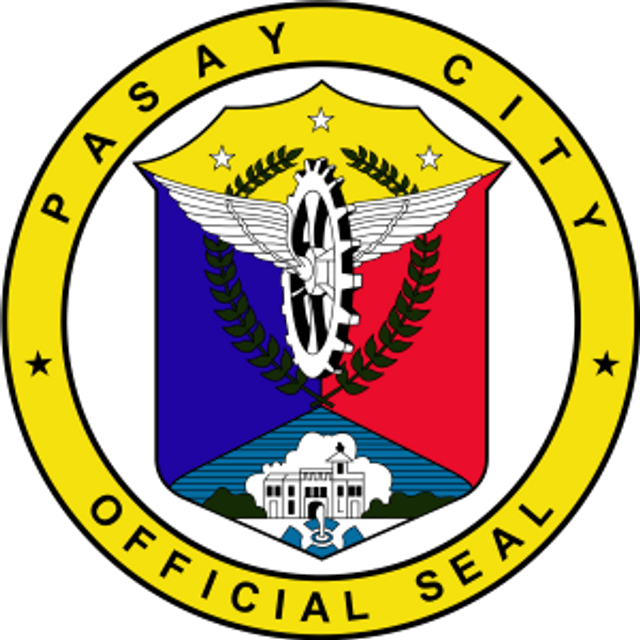
Pasay

Pasay | |
|---|---|
Highly Urbanized City | |
| City of Pasay | |
 Aerial view of Pasay | |
| Nickname(s): The Travel City | |
| Motto(s): Aim High Pasay! Tapat kayong Pinaglilinkuran! | |
| Anthem: Pasay, Mabuhay Ka! | |
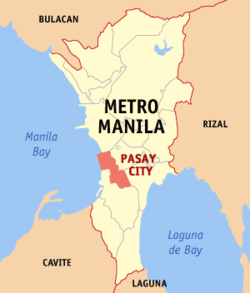 Map of Metro Manila with Pasay highlighted | |
 | |
| Coordinates:14°33′N 121°00′E [30] | |
| Country | |
| Region | National Capital Region (NCR) |
| Province | none(Former part of Rizal province until 1975) |
| District | Lone district |
| Founded | December 2, 1863 |
| Cityhood | June 21, 1947 (city) |
| Highly urbanized city | December 22, 1979 |
| Barangays | ****201 (see Barangays) |
| Government | |
| • Type | Sangguniang Panlungsod |
| • Mayor | Imelda Calixto-Rubiano |
| • Vice Mayor | Noel del Rosario |
| • Congressman | Antonino Calixto |
| • Councilors | 1st District
2nd District
|
| • Electorate | 285,538 voters (2019) |
| Area | |
| • Total | 13.97 km2(5.39 sq mi) |
| Population (2015 census)[3] | |
| • Total | 416,522 |
| • Density | 30,000/km2(77,000/sq mi) |
| Demonym(s) | Pasayeño |
| Time zone | UTC+8 (PST) |
| ZIP code | 1300–1309 |
| PSGC [31] | 137605000 [32] |
| IDD:area code | +63 (0)2 |
| Climate type | tropical monsoon climate |
| Income class | 1st city income class |
| Revenue (₱) | 3,535.5 million (2016) |
| Website | www.pasay.gov.ph [33] |
Pasay, officially the City of Pasay, (Tagalog: Lungsod ng Pasay), or simply known as Pasay City, is a 1st class highly urbanized city in Metro Manila, Philippines. According to the 2015 census, it has a population of 416,522 people.[3]
Due to its location just south of the City of Manila, Pasay quickly became an urban town during the American colonial period.
Pasay | |
|---|---|
Highly Urbanized City | |
| City of Pasay | |
 Aerial view of Pasay | |
| Nickname(s): The Travel City | |
| Motto(s): Aim High Pasay! Tapat kayong Pinaglilinkuran! | |
| Anthem: Pasay, Mabuhay Ka! | |
 Map of Metro Manila with Pasay highlighted | |
 | |
| Coordinates:14°33′N 121°00′E [30] | |
| Country | |
| Region | National Capital Region (NCR) |
| Province | none(Former part of Rizal province until 1975) |
| District | Lone district |
| Founded | December 2, 1863 |
| Cityhood | June 21, 1947 (city) |
| Highly urbanized city | December 22, 1979 |
| Barangays | ****201 (see Barangays) |
| Government | |
| • Type | Sangguniang Panlungsod |
| • Mayor | Imelda Calixto-Rubiano |
| • Vice Mayor | Noel del Rosario |
| • Congressman | Antonino Calixto |
| • Councilors | 1st District
2nd District
|
| • Electorate | 285,538 voters (2019) |
| Area | |
| • Total | 13.97 km2(5.39 sq mi) |
| Population (2015 census)[3] | |
| • Total | 416,522 |
| • Density | 30,000/km2(77,000/sq mi) |
| Demonym(s) | Pasayeño |
| Time zone | UTC+8 (PST) |
| ZIP code | 1300–1309 |
| PSGC [31] | 137605000 [32] |
| IDD:area code | +63 (0)2 |
| Climate type | tropical monsoon climate |
| Income class | 1st city income class |
| Revenue (₱) | 3,535.5 million (2016) |
| Website | www.pasay.gov.ph [33] |
History
Early history
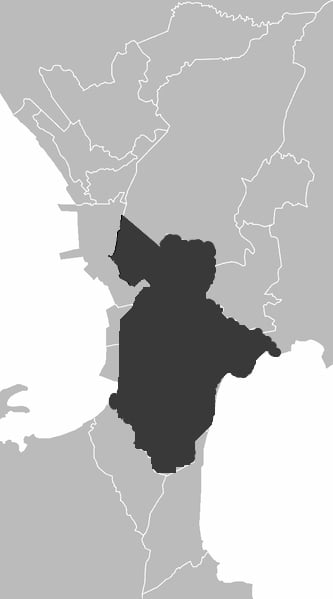
The map of territory once said to be under the rule of Namayan, which includes Pasay, in modern Metro Manila
In local folk history about the period before the arrival of Spanish colonizers, Pasay is said to have been part of Namayan (sometimes also called Sapa), a confederation of barangays which supposedly controlled territory stretching from Manila Bay to Laguna de Bay, and which, upon the arrival of the Spanish, eventually became known as Sta. Ana de Sapa (modern day Santa Ana, Manila).[4] According to these legends, the ruler of Namayan bequeathed his territories in what is now Culi-culi, Pasay, and Baclaran to one of his sons, named Pasay, explaining the origin of the name.[4]
In another version of the legend, it was Rajah Sulayman of Maynila who bequeathed the territory to his child - also named Pasay, but this time a daughter with the title of Dayang-dayang.[4]
Spanish era
On May 19, 1571, Miguel López de Legazpi took formal possession of the Rajahnate of Maynila and its surrounding polities in the name of the Spanish crown.
Of the many religious orders that came, it was the Augustinian Order who would figure predominantly in the evangelisation of Pasay. The parish of Pasay was governed from the old Namayan capital, since renamed Sta. Ana de Sapa, which was under the jurisdiction of the Franciscans. The promise of space in Heaven prompted early native converts to donate their possessions to the Church, with folklore recounting how a baptized Pasay on her deathbed donated her vast estate to the Augustinians. Most of Pasay went to friar's hands either via donation or by purchase; many natives were also forced to divest of their properties to cope with stringent colonial impositions. In 1727, the Augustinians formally took over Pasay and attached it to the Parish of Nuestra Señora de los Remedios in Malate. In that year, Pasay was renamed "Pineda" in honour of Don Cornelio Pineda, a Spanish horticulturist.
In 1862, a number of prominent citizens of Pasay sent a petition to the civil and ecclesiastical authorities asking that they be allowed to manage their own political and religious affairs. On December 2, 1863, Pasay became a pueblo upon the recommendation of the Archbishop of Manila, Gregorio Melitón Martínez Santa Cruz.
Revolution and the Spanish–American War
Pasay produced numerous heroes during the Philippine Revolution. The Katipunan, the organization founded by Andrés Bonifacio that spearheaded the revolution, had a chapter in Pineda organized by Pascual Villanueva, Jacinto Ignacio, and Valentin Ignacio. Several women also fought for the cause of the Katipunan including Marcela Marcelo. The execution of José Rizal, who authored the novels Noli Me Tangere and El Filibusterismo (considered seditious by the colonial government) on December 30, 1896, fanned the flames of the Revolution.
General Emilio Aguinaldo meanwhile declared the independence of the First Philippine Republic on June 12, 1898, and issued decrees providing political reorganization in the country. With this, Don Catalino became Pasay's first Presidente municipal (equivalent to today's Mayor).
Pineda was made the command outpost of the Primera Zona de Manila under Gen. Mariano Noriel, but Gen. Merritt appealed that the Pineda outpost turned over to the Americans so that they could be closer to the Spanish lines. Thinking Americans were allies, Noriel left Pineda on July 29, allowing American General Greene to transfer. When Intramuros was finally captured, the Filipinos were denied entry to the walled city. Since then, tension simmered between Filipino and American troops, with both sides assigned respective zones but neither observed boundary lines. On the night of February 4, 1899, four Filipinos crossed the American line in Santa Mesa, Manila, and shots were exchanged, triggering the Philippine–American War.
On May 19, 1899, General Noriel was given command again of Pineda. In June, Noriel together with General Ricarte almost defeated the American forces had they exploited the exhaustion of the enemy in the Battle of Las Piñas. Instead, their forces were attacked by American reinforcements and bombarded by warships. The assault forced them to abandon Pineda to occupation by American forces.
American period
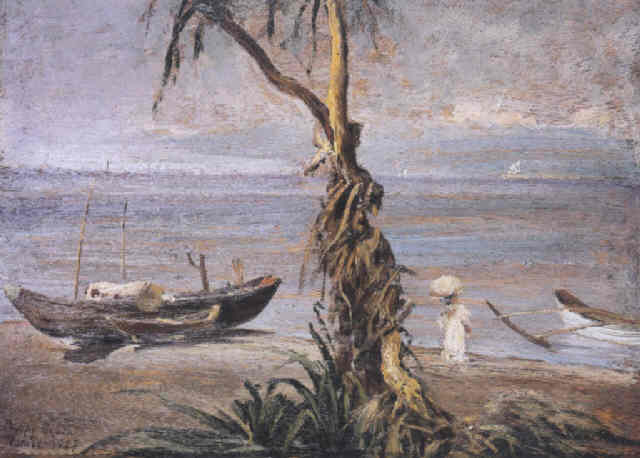
Pasay beach, Manila, oil on board by Fabián de la Rosa, 1927
On June 1, 1901, Pineda was incorporated into the Province of Rizal. Antonio Dancel was appointed a provincial governor and Pascual Villanueva as municipal president. On August 4, 1901, a resolution was passed petitioning that the original name of Pasay be returned. On September 6, 1901, the Philippine Commission, acting on the request of the townsfolk, passed Act No. 227 renaming Pineda back to Pasay.[5] Two years later, on October 12, 1903, Act No. 942 merged Pasay with the southern municipality of Malibay, expanding its territory.[6] With a population of 8,100 in 1903, Pasay was placed under the fourth-class category together with 9 other municipalities.
Friar lands, then nationalized, were turned into subdivisions. Soon the Pasay Real Estate Company offered friar lands as residential lots for sale or for lease to foreign investors. Postal, telegraph, and telephone lines were installed and branches of Philippine Savings Bank were established. In 1907 a first-class road from Pasay to Camp Nichols was completed. Others were repaired including the old Avenida Mexico now called the Taft Avenue extension. Transportation services improved. Among the first buses plying routes to Pasay were Pasay Transportation, Raymundo Transportation, Try-tran, and Halili Transit.
By 1908, Meralco tranvia (electric tram car) lines linked Pasay to Intramuros, Escolta, San Miguel, San Sebastian, and San Juan. Automobiles took to the streets, testing their maximum 20 km/h speed on Taft Avenue. Marvel after marvel continued to fascinate the Pasayeños. On April 11, 1914, Pasay entered the Aviation Age, when Ms. Cora Wong, a nurse at the Chinese General Hospital, became the first woman in the Philippines to fly as a passenger on a flight with Tom Gunn in a Curtiss seaplane off Pasay Beach. Real estate was cheap. Much of the bayside area beyond Luneta was swamp but American ex-soldiers were quick to seize the opportunity to develop it for residential purposes. By 1918, Pasay had a population of 18,697 because of the exodus of prominent Filipino families and government officials to this seaside town including future president Manuel L. Quezon. By the 1930s, the former rural town had become a suburb of the capital city.
Japanese occupation and the Second Republic
World War II came and on December 26, 1941, McArthur issued a proclamation declaring Manila and its suburbs (Caloocan, Quezon City, San Juan, Mandaluyong, Makati, and Pasay) an open city. On New Year's Day, 1942 Quezon, while in Corregidor, called his secretary Jorge Vargas and appointed him by executive order "the Mayor of Greater Manila" which included Pasay. The mayor of Pasay was then Rufino Mateo, governing a town of more than 55,161. During the WWII many Pasayeños joined in the fight against the Japanese. Jose P. Maibag, born and bred in Pasay, laid out underground networking. Carlos Mendoza, a resident of Barrio San Roque, together with 14 others, formed a mobile broadcasting station called "The Voice of Juan dela Cruz." Unfortunately on July 11, 1942, Japanese military police pounced the group. Carling Mendoza, alias Juan de la Cruz" and other members of the group were brought to the old Bilibid Prison and suffered the kind of torture they talked about on the radio.
Pasay had to redo the signs all over town, with Filipino was ordered to prevail over English. The national language became a core subject in the secondary school curriculum, while Japanese was taught as well at all levels of education. On October 14, 1943, Japan proclaimed the Second Philippine Republic. Meantime, food had become so scarce that prices soared. Pasay residents began to move away from the city to the provinces outside. In the middle of February up to early March 1945, as the combined Allied forces began to converge on the way to the Manila area northwards from the south, Pasay suffered enormous damage during the month-long Battle of Manila, and many residents perished either by the Japanese or friendly fire from the combined Filipino and American forces.
Third Republic and the conversion to city status
On February 27, 1945, General MacArthur turned over the government to President Sergio Osmeña. One of Osmeña's first acts was to dissolve the Greater Manila Complex. Caloocan, San Juan, Mandaluyong, Makati, Pasay, and Paranaque were returned to their original province of Rizal. He then appointed Juan S. Salcedo, born in Pasay in 1904, as Director of Philippine Health, and then as executive officer of the Philippine Rehabilitation Administration in charge of national recovery from the devastation wrought by the Japanese occupation. Osmeña appointed Adolfo Santos as prewar vice mayor of Pasay, in place of incumbent Moises San Juan who died during the war.
Ignacio Santos Diaz, a congressman from the first district of Pasay, pushed for the conversion of the town into a city and it to be named after Rizal. Republic Act No. 183 was signed into law by President Roxas on June 21, 1947, officially establishing Rizal City,[7] with Mateo Rufino as Mayor and a population of 88,738. As of June 1948, the city had revenues of P472,835. There was just one hitch; the residents could not get themselves to call their city by its new name. After two years, eight months, and twelve days of trying, the force of habit continued to prevail. Pasay Congressman Eulogio Rodriguez, Jr. filed a bill returning the city to its original name. On May 3, 1950, President Elpidio Quirino, once a resident of Pasay himself, signed into law Republic Act No. 437, which changed the name of Rizal City to Pasay City.[8]
It was also in the 1940s when houses of faith started rising in different parts of Pasay to help people heal their bruised souls. Among them was the Church of Our Lady of Sorrows, the Libreria de San Pablo Catholic Women's League, Caritas, the nutrition center, and the grotto of Our Lady of Lourdes. In 1951, two parishes were established -the Parish of San Isidro Labrador and the Parish of San Rafael. On June 14, 1955, Pasay City regained its power to choose its leader. Pablo Cuneta ran against one-time Mayor Adolfo Santos and became the city's first elected mayor. In 1959, he campaigned again and won against his former vice mayor, Ruperto Galvez. On December 30, 1965, Ferdinand E. Marcos occupied Malacañang Palace as the new President of the Philippines, with Fernando Lopez, a resident of Pasay, as Vice-President. From that moment Imelda Romualdez Marcos became involved in national affairs. On the northern boundary of Pasay, she started filling the waterfront on Manila Bay to build the Cultural Center which was a world-class arts complex. She would add three more architectural showpieces on reclaimed land in Pasay: the Folk Arts, Film Center, and the Convention Center.
In 1967, Jovito Claudio won for the mayoralty race against Pablo Cuneta. In the following year, an assassination attempt occurred in Pasay when a Bolivian surrealist painter lunged at Pope Paul VI, with a knife grazing his chest. In 1971, Cuneta was re-elected as mayor.
New Society
On December 7, 1972, almost two months after martial law was declared, an assassin tried to kill Imelda Marcos. The event took place in Pasay, on live television, while Mrs. Marcos was distributing prizes to the winners of the National Beautification and Cleanliness contest. She suffered some wounds and broken nails but on the whole, she emerged unscathed from that close encounter. On the second anniversary of martial law, Marcos issued Presidential Decree No. 557, returning to every barrio in the country the barangays. Not long after the decree had been put into effect, the Metropolitan Manila Commission and the Department of Local Government instructed Pasay to create its own barangays. Mayor Cuneta, in response, ordered the creation of 487 barangays. Upon the firm suggestion of Secretary Jose Roño of the Department of Local Government, the number of barangays was cut down to two hundred.
On November 7, 1975, Marcos appointed the First Lady, Imelda, as governor of Metro Manila. The federation consolidated 13 towns and 4 cities including Pasay, which was removed from Rizal Province.
Pasay was the host city of Miss Universe 1974, the first time this event had been held in the morning and in the Asia Pacific, and thus was in the international spotlight in the leadup to the pageant day.[9]
People Power and contemporary period
The situation changed in the city in the immediate aftermath of the People Power Revolution. Cuneta left his post to be replaced by two acting mayors, Eduardo Calixto and Norman Urbina, only to be reelected in 1988 and serving for three more terms, before handing over to Jovito O. Claudio in 1998. Upon the end of his term, he was the city's longest ever city mayor. Claudio, himself replaced by the then vice mayor Wenceslao "Peewee" Trinidad in 2000, saw the building of the Manila Metro Rail Transit System Line 3 southern terminus in the city, and the Pasay City General Hospital and NAIA Terminal 2 were both opened to the public. All these and other projects spurred a new era of massive growth in the city that continues to this day. One end result is that even today, the EDSA Entertainment Complex, located just to the city's west along EDSA, just miles from the Baclaran district of Paranaque, is known for adult entertainment, including prostitution.[10][11]
In 2006 the SM Mall of Asia, the 4th biggest overall in the country, was opened, and the area around this mall began to grow into the city's business center in the years that followed. 2 years later, the NAIA Terminal 3 opened its doors in July 2008.
Geography
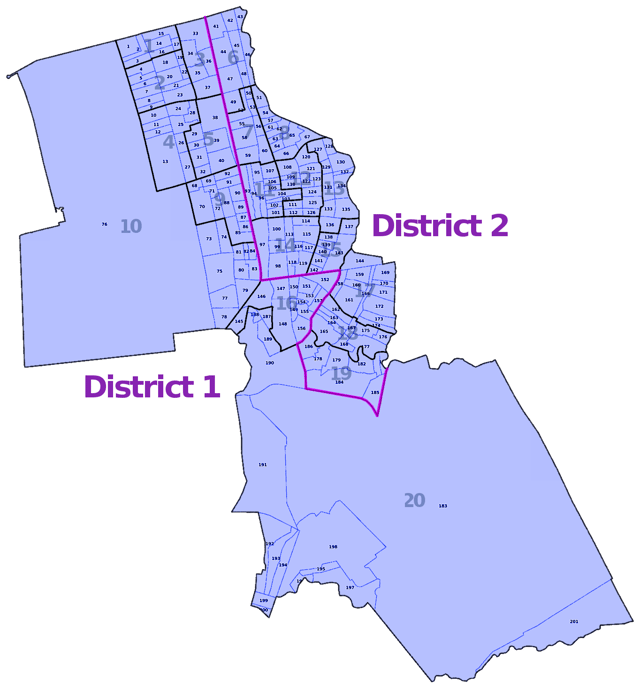
Pasay City zones and barangays
Pasay City covers a total land area of 18.64 square kilometres (7.20 sq mi),[12][13] making it the third smallest political subdivision in the National Capital Region and fourth in the whole country. It borders City of Manila to the north, Parañaque to the south, Makati and Taguig to the northeast, and Manila Bay to the west. The city can be divided into three distinct areas: the city's urban area with an area of 5.505 square kilometres (2.125 sq mi); the Civil Aeronautics Administration (CAA) complex, which includes the Ninoy Aquino International Airport (NAIA) and the Villamor Airbase, with an area of 9.5 square kilometres (3.7 sq mi); and the reclaimed land from Manila Bay with an area of 4.00 square kilometres (1.54 sq mi).[14]
Pasay is composed of seven districts, subdivided into 20 zones, with a total of 201 barangays. The barangays do not have names but are only designated with sequential numbers. The largest zone, with an area of 5.10 square kilometres (1.97 sq mi), is Zone 19, which covers barangays 178 and 191. The smallest zone with an area of 10 hectares (25 acres) is Zone 1, covering Barangays 1 to 3 and 14 to 17.[14]
- Populated places / barangays in Pasay
Apelo Cruz
Baclaran
Baltao
Bay City
Cabrera
Cartimar
Cuyegkeng
Don Carlos Village
Edang
F. B. Harrison
Juan Sumulong
Kalayaan
Leveriza
Libertad
Malibay
Manila Bay Reclamation
Marcela Marcelo
Maricaban
M. Dela Cruz
Newport City
Nichols
Padre Burgos
Pasay Rotonda
Philippine International Convention Center
Pildera I
Pildera II
Rivera Village
San Pablo
San Isidro
San Jose
San Rafael
San Roque
Santa Clara
Santo Niño
Tramo
Tripa de Gallina
Ventanilla
Villamor Air Base
Climate
Under the Köppen climate classification system, Pasay features a tropical savanna climate (Köppen climate classification Aw).
| Climate data for Pasay (Ninoy Aquino International Airport) 1981–2010, extremes 1947–2012 | |||||||||||||
|---|---|---|---|---|---|---|---|---|---|---|---|---|---|
| Month | Jan | Feb | Mar | Apr | May | Jun | Jul | Aug | Sep | Oct | Nov | Dec | Year |
| Record high °C (°F) | 35.8 (96.4) | 35.1 (95.2) | 36.5 (97.7) | 37.8 (100.0) | 38.1 (100.6) | 38.0 (100.4) | 36.0 (96.8) | 35.2 (95.4) | 34.9 (94.8) | 36.0 (96.8) | 35.8 (96.4) | 34.2 (93.6) | 38.1 (100.6) |
| Average high °C (°F) | 30.2 (86.4) | 31.0 (87.8) | 32.5 (90.5) | 34.1 (93.4) | 33.8 (92.8) | 32.5 (90.5) | 31.3 (88.3) | 30.8 (87.4) | 31.0 (87.8) | 31.1 (88.0) | 31.1 (88.0) | 30.2 (86.4) | 31.6 (88.9) |
| Daily mean °C (°F) | 26.1 (79.0) | 26.7 (80.1) | 28.0 (82.4) | 29.5 (85.1) | 29.7 (85.5) | 28.8 (83.8) | 28.0 (82.4) | 27.7 (81.9) | 27.8 (82.0) | 27.7 (81.9) | 27.4 (81.3) | 26.5 (79.7) | 27.8 (82.0) |
| Average low °C (°F) | 22.0 (71.6) | 22.5 (72.5) | 23.6 (74.5) | 25.0 (77.0) | 25.5 (77.9) | 25.1 (77.2) | 24.6 (76.3) | 24.6 (76.3) | 24.6 (76.3) | 24.3 (75.7) | 23.7 (74.7) | 22.7 (72.9) | 24.0 (75.2) |
| Record low °C (°F) | 14.8 (58.6) | 14.6 (58.3) | 16.0 (60.8) | 18.7 (65.7) | 19.1 (66.4) | 20.0 (68.0) | 18.3 (64.9) | 17.4 (63.3) | 19.1 (66.4) | 18.0 (64.4) | 17.2 (63.0) | 16.3 (61.3) | 14.6 (58.3) |
| Average rainfall mm (inches) | 6.8 (0.27) | 4.2 (0.17) | 4.0 (0.16) | 16.0 (0.63) | 70.4 (2.77) | 265.2 (10.44) | 316.7 (12.47) | 418.4 (16.47) | 255.2 (10.05) | 283.4 (11.16) | 99.0 (3.90) | 28.6 (1.13) | 1,767.8 (69.60) |
| Average rainy days(≥ 0.1 mm) | 2 | 1 | 1 | 1 | 6 | 14 | 16 | 19 | 16 | 14 | 8 | 3 | 101 |
| Average relative humidity (%) | 75 | 72 | 68 | 67 | 72 | 77 | 81 | 83 | 83 | 80 | 78 | 76 | 76 |
| Source: PAGASA[15][16] | |||||||||||||
Demographics
| Population census of Pasay | |||||||||||||||||||||||||||||||||||||||||||||||||
|---|---|---|---|---|---|---|---|---|---|---|---|---|---|---|---|---|---|---|---|---|---|---|---|---|---|---|---|---|---|---|---|---|---|---|---|---|---|---|---|---|---|---|---|---|---|---|---|---|---|
|
| ||||||||||||||||||||||||||||||||||||||||||||||||
| Source: Philippine Statistics Authority[3][17][18][19] | |||||||||||||||||||||||||||||||||||||||||||||||||
Economy
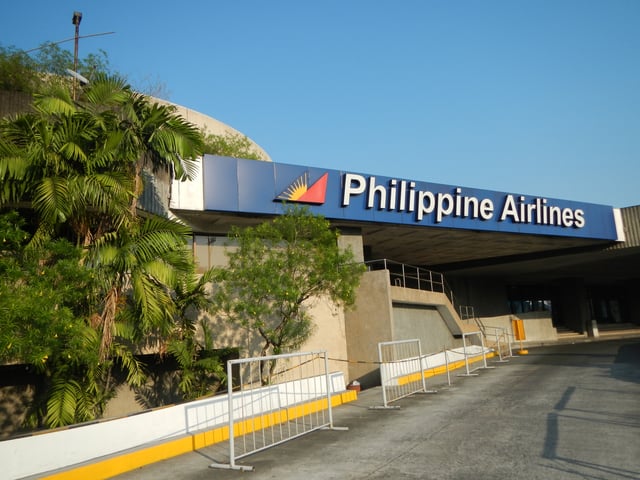
Headquarters of Philippine Airlines
Philippine Airlines is headquartered in the Philippine National Bank Financial Center beside the World Trade Center Manila in Pasay City.[20] Spirit of Manila Airlines has its headquarters in Roxas Sea Front Garden in Pasay City.[21] PAL Express, Cebu Pacific, Air Juan, Interisland Airlines have their headquarters on the grounds of Ninoy Aquino International Airport and in Pasay City.[22][23] Oishi (Liwayway), a snack company, also has its headquarters in Pasay.[24]
National government offices found in Pasay include: Office of the Vice-President of the Philippines, Senate of the Philippines, Department of Foreign Affairs (DFA), Civil Aviation Authority of the Philippines, Civil Aeronautics Board, Manila International Airport Authority, the Philippine Department of Trade and Industry's export promotions agency – the Center for International Trade Expositions and Missions (CITEM) – located in the International Trade Complex's Golden Shell Pavilion, and the Overseas Workers Welfare Administration (OWWA), Office for Transportation Security (OTS). The main office of the Philippine National Bank is located in the city.
LBC Express headquarters is located at the Star Cruises Centre in the Newport Cybertourism Zone of Pasay City.
Local government
Pasay is governed primarily by the city mayor, the vice mayor and the city councilors. The mayor acts as the chief executive of the city while the city councilors act as its legislative body. The vice mayor, besides taking on mayoral responsibilities in case of a temporary vacancy, acts as the presiding officer of the city legislature. The legislative body is composed of 12 regular members (6 per district) and representatives from the barangay and the youth council.[25]
| City Government of Pasay (2019–2022) | |
|---|---|
| Representative | |
| Antonio G. Calixto | |
| Mayor | |
| Imelda Calixto-Rubiano | |
| Vice Mayor | |
| Noel del Rosario | |
| Sangguniang Panlungsod Members | |
| 1st District | 2nd District |
| Mark Anthony Calixto | Allan Panaligan |
| Grace Santos | Donnabel Vendivel |
| Ma. Antonia Cuneta | Arnel Regio Arceo Jr. |
| Abraham Albert Alvina | Jose Calixto Isidro Jr. |
| Marlon Pesebere | Editha Manguerra |
| Ricardo Santos | Aileen Padua-Lopez |
| ABC President | |
| Julie G. Gonzales | |
| SK Federation President | |
Sports
Pasay will host some matches in the 2023 FIBA Basketball World Cup at the Mall of Asia Arena.
Transportation
Airport
The city is one of the two cities Ninoy Aquino International Airport is located in, along with Parañaque City. Terminals 2, 3 and 4 are located in Pasay City. Villamor Airbase of the Philippine Air Force is also located here.
Roads
Highways and main thoroughfares
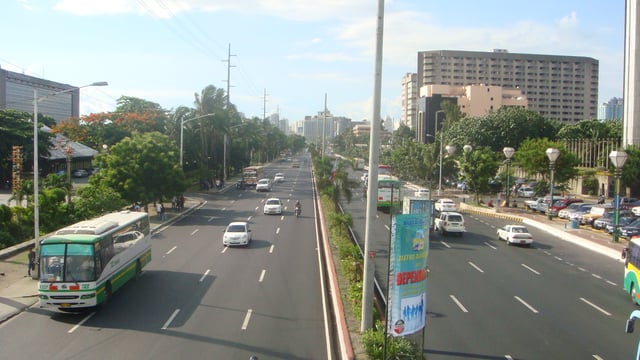
View of Roxas Boulevard from the Libertad overpass
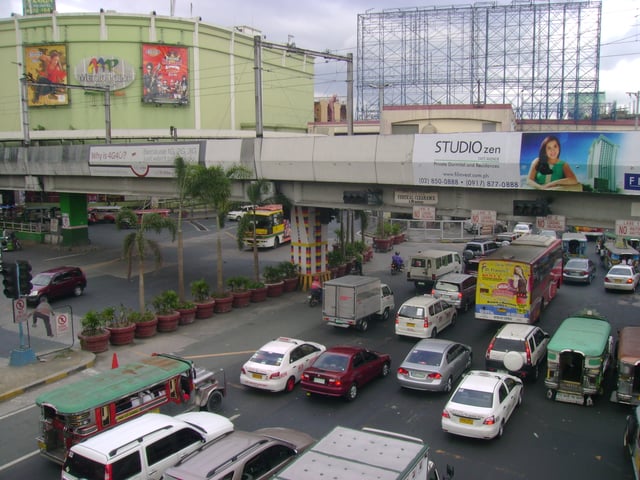
"Pasay Rotonda", the intersection of EDSA and Taft Avenue
Pasay City is served by several highways and major thoroughfares. Epifanio delos Santos Avenue (EDSA), Roxas Boulevard, Gil Puyat Avenue (Buendia Avenue) and Taft Avenue function as the city's main thoroughfares. Secondary thoroughfares include Andrews Avenue, Antonio Arnaiz Avenue (formerly known as Libertad Street within Pasay), Diosdado Macapagal Boulevard, Ninoy Aquino Avenue and NAIA Road (MIA Road).
Expressways
Three expressways serve Pasay and other parts of Metro Manila and Calabarzon; Metro Manila Skyway, an elevated expressway which is a component of Radial Road 3 (R-3) and Asian Highway 26 (AH26), passes on and serves as the Pasay-Taguig boundary. South Luzon Expressway, commonly called as SLEX and also components of Radial Road 3 and Asian Highway 26, follows a similar route with the Metro Manila Skyway, but runs directly below it, on tbe ground. NAIA Expressway, an elevated tolled expressway, serves Terminals 2 and 3 of the Ninoy Aquino International Airport, and fully opened in December 2016.
Public transport
Jeepneys
Jeepneys ply the city's arterial roads, and serve the city's populated areas and nearby cities.
Buses
Buses provide city (commuter) and provincial (intercity) operation on Pasay. Provincial bus terminals are mostly found near the Gil Puyat Station, and a new terminal, the Southwest Provincial Bus Terminal, is found in HK Sun Plaza, on Macapagal Boulevard.
Rail
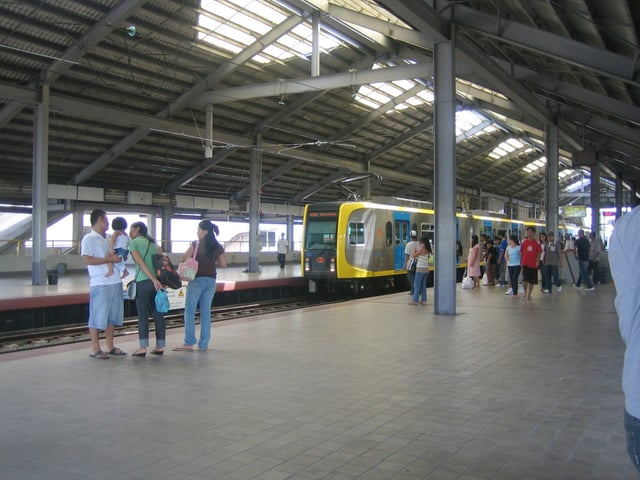
The Baclaran Station of Line 1
This city is served by two railway lines, the Line 1 and Line 3. Line 1 has four stations in Pasay, namely Gil Puyat (Buendia), Libertad, EDSA, Baclaran, and its depot is located along Airport Road. Line 3 has only one station, named Taft Avenue, which serves as an interchange with Line 1.
Other
Tricycles and pedicabs serves the barangays. Multicab services connect SM Mall of Asia with Baclaran in Parañaque, Pasay Rotonda, and Cash N' Carry in Makati. Vans also provide service throughout the city and to other destinations in Metro Manila.
Unity Run
On the list of largest running events in the world, based on the number of participants a record 209,000 registered running enthusiasts participated in 2012 Kahit Isang Araw Lang: Unity Run which started and ended at the SM Mall of Asia grounds in Pasay City.
The second edition of the race surpassed the Guinness World record of 116,086 participants posted in the Run for Pasig River on Oct 10, 2010.[26]
Education
The Department of Education (DepEd) Division of City Schools – Pasay operates 18 public elementary schools and 8 high schools, and operations are divided into four districts: Pasay North, Pasay East, Pasay South, and Pasay West. Special education is provided by the Philippine School for the Deaf and Philippine National School for the Blind, Pasay City SPED Center, and one Alternative Learning System (ALS) center. Numerous private schools, including Catholic and parochial schools, also operate in the city, like the St. Mary's Academy, operated by nuns of the Religious of the Virgin Mary.
- Colleges and universities
Pamantasan ng Lungsod ng Pasay (City University of Pasay)
Manila Tytana Colleges
Asian Institute of Maritime Studies
Lacson College
Philippine Law School
Wesleyan College of Manila
Arellano University School of Law - Mabini Campus
Arellano University Jose Abad Santos Campus - Pasay Campus
Philippine State College of Aeronautics
Airlink International Aviation College
Manila Adventist College
Southeastern College
STI Pasay
San Juan de Dios College
International Electronics and Technical Institute Pasay
Diplomatic missions
Countries that have set up permanent diplomatic offices or embassies in the city include:
Twin towns and sister cities
International
[[INLINE_IMAGE|//upload.wikimedia.org/wikipedia/en/thumb/a/a4/Flag_of_the_United_States.svg/23px-Flag_of_the_United_States.svg.png|//upload.wikimedia.org/wikipedia/en/thumb/a/a4/Flag_of_the_United_States.svg/35px-Flag_of_the_United_States.svg.png 1.5x, //upload.wikimedia.org/wikipedia/en/thumb/a/a4/Flag_of_the_United_States.svg/46px-Flag_of_the_United_States.svg.png 2x|United States|h12|w23|thumbborder flagicon-img flagicon-img]] Union City, California, United States
[[INLINE_IMAGE|//upload.wikimedia.org/wikipedia/en/thumb/a/a4/Flag_of_the_United_States.svg/23px-Flag_of_the_United_States.svg.png|//upload.wikimedia.org/wikipedia/en/thumb/a/a4/Flag_of_the_United_States.svg/35px-Flag_of_the_United_States.svg.png 1.5x, //upload.wikimedia.org/wikipedia/en/thumb/a/a4/Flag_of_the_United_States.svg/46px-Flag_of_the_United_States.svg.png 2x|United States|h12|w23|thumbborder flagicon-img flagicon-img]] Sacramento, California, United States
[[INLINE_IMAGE|//upload.wikimedia.org/wikipedia/commons/thumb/0/09/Flag_of_South_Korea.svg/23px-Flag_of_South_Korea.svg.png|//upload.wikimedia.org/wikipedia/commons/thumb/0/09/Flag_of_South_Korea.svg/35px-Flag_of_South_Korea.svg.png 1.5x, //upload.wikimedia.org/wikipedia/commons/thumb/0/09/Flag_of_South_Korea.svg/45px-Flag_of_South_Korea.svg.png 2x|South Korea|h15|w23|thumbborder flagicon-img flagicon-img]] Jecheon, South Korea
[[INLINE_IMAGE|//upload.wikimedia.org/wikipedia/commons/thumb/7/72/Flag_of_the_Republic_of_China.svg/23px-Flag_of_the_Republic_of_China.svg.png|//upload.wikimedia.org/wikipedia/commons/thumb/7/72/Flag_of_the_Republic_of_China.svg/35px-Flag_of_the_Republic_of_China.svg.png 1.5x, //upload.wikimedia.org/wikipedia/commons/thumb/7/72/Flag_of_the_Republic_of_China.svg/45px-Flag_of_the_Republic_of_China.svg.png 2x|Taiwan|h15|w23|thumbborder flagicon-img flagicon-img]] Tainan, Taiwan
Local
[[INLINE_IMAGE|//upload.wikimedia.org/wikipedia/commons/thumb/9/99/Flag_of_the_Philippines.svg/23px-Flag_of_the_Philippines.svg.png|//upload.wikimedia.org/wikipedia/commons/thumb/9/99/Flag_of_the_Philippines.svg/35px-Flag_of_the_Philippines.svg.png 1.5x, //upload.wikimedia.org/wikipedia/commons/thumb/9/99/Flag_of_the_Philippines.svg/46px-Flag_of_the_Philippines.svg.png 2x|Philippines|h12|w23|thumbborder flagicon-img flagicon-img]] Las Piñas, Metro Manila
[[INLINE_IMAGE|//upload.wikimedia.org/wikipedia/commons/thumb/9/99/Flag_of_the_Philippines.svg/23px-Flag_of_the_Philippines.svg.png|//upload.wikimedia.org/wikipedia/commons/thumb/9/99/Flag_of_the_Philippines.svg/35px-Flag_of_the_Philippines.svg.png 1.5x, //upload.wikimedia.org/wikipedia/commons/thumb/9/99/Flag_of_the_Philippines.svg/46px-Flag_of_the_Philippines.svg.png 2x|Philippines|h12|w23|thumbborder flagicon-img flagicon-img]] Parañaque, Metro Manila
Notable people
Francisco Coching, Filipino comic book illustrator and writer
Pablo Cuneta, former Pasay mayor; father of Sharon Cuneta
Sharon Cuneta, Filipino singer, actress and television host
King Girado, Filipino singer, musician, model and actor
Nina Girado, pop/R&B singer, occasional songwriter, record producer, TV and radio personality at ABS-CBN
Carl Guevara, actor and model
Maricel Laxa, Filipino comedian and actress
Anita Linda, Filipino film actress
Fernando Lopez, former 3rd and 7th Vice President of the Philippines
Lisa Macuja-Elizalde, Filipino prima ballerina; in 1984, became the first Filipino and the first foreign soloist to join the Kirov Ballet
Vhong Navarro, comedian, dancer, member of Streetboys
Chariz Solomon, Filipina actress and television personality
Darwin Ramos, Servant of God, Filipino teenager.
See also
Bay City, Metro Manila
Pasay City West High School
